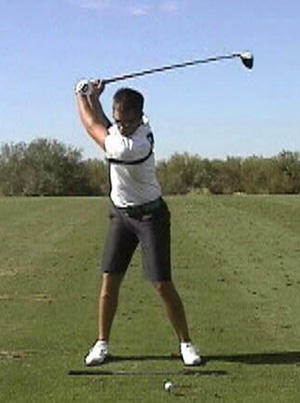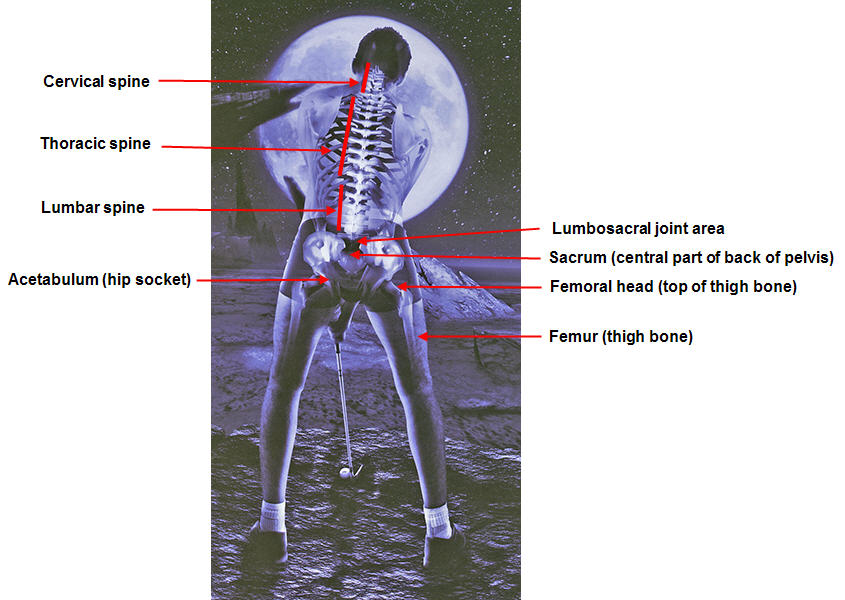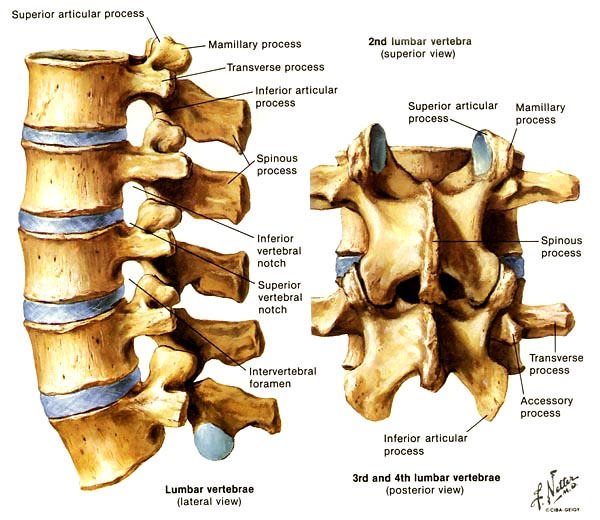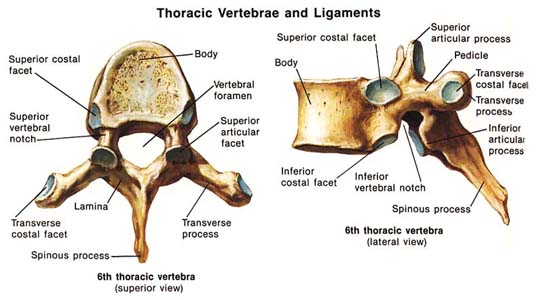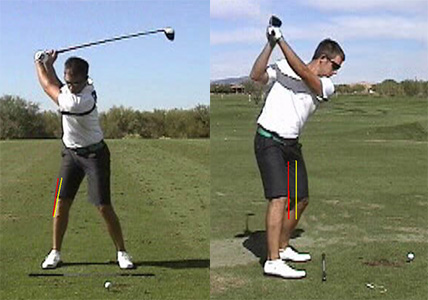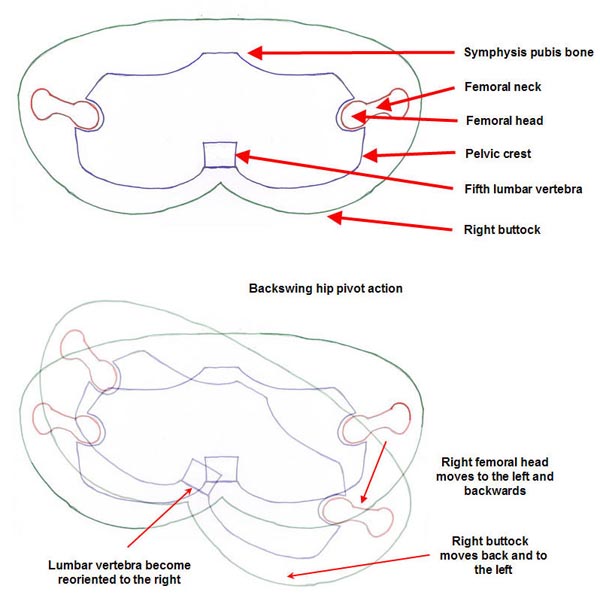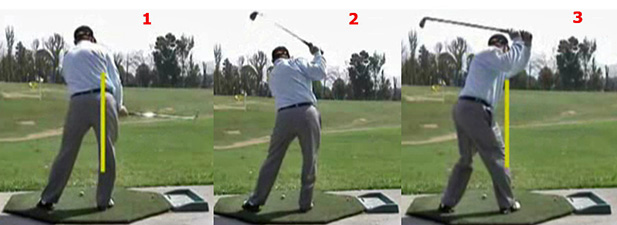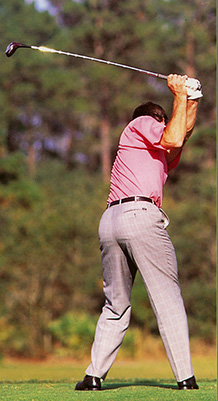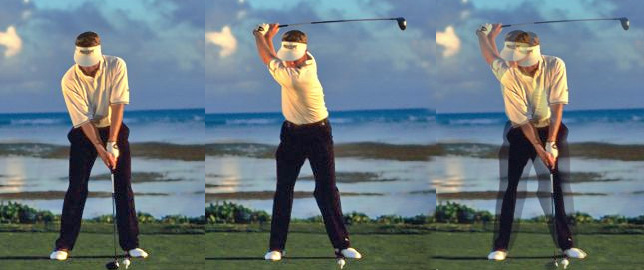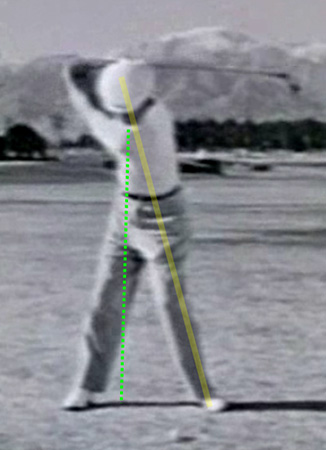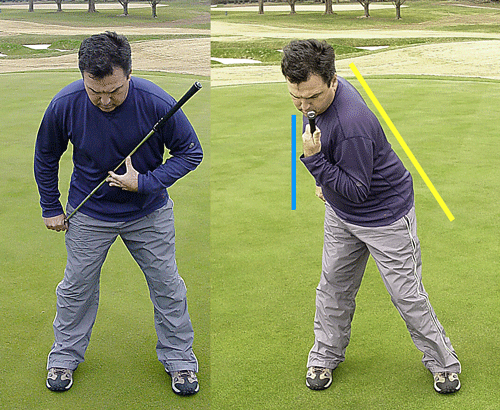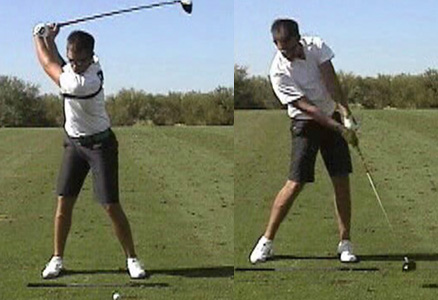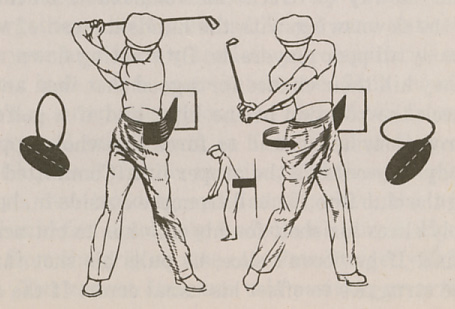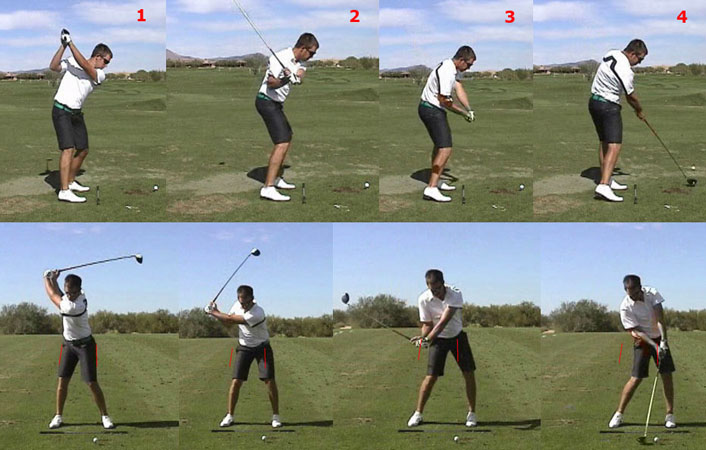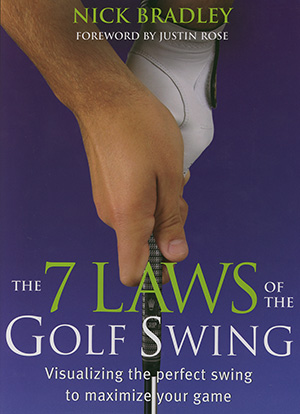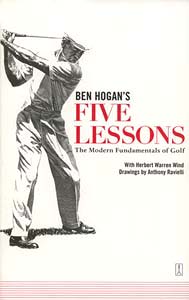The Backswing and Downswing Hip Pivot Movements: Their Critical Role in the Golf Swing
Click here to go to the index page.
Introduction
I have recently come to realise that the backswing/downswing hip pivot movements play a critical role in the full golf swing, and I believe that their importance is not fully appreciated. In this review paper, I will describe the backswing/downswing hip pivot movements and demonstrate why they play a critical role in the full golf swing.I also believe that many beginner golfers totally misunderstand what the hips are doing when they move in the golf swing. I am a member of a number of online golf discussion forums and the topic of "how best to start the downswing with a hip move" frequently comes up for discussion. Some golfers, participating in the discussion forum, recommend that one should initiate the downswing lower body move with a right hip rotation movement (a hip squaring movement) where one rotates the right hip forward in the direction of the ball-target line. What they don't realise is that it is very difficult to rotate the right hip forward at the start of the downswing when most of the body weight is situated over the right femoral head. Downhill skiers understand this point and that's why they use their ski poles to help unload the ipsilateral hip joint before they initiate a turn. Golfers don't have an accessory mechanical aid that can help them unload the right hip at the very start of the downswing. A second important point that many beginner golfers don't appreciate is that the hip squaring action at the start of the downswing shouldn't involve a movement of the right hip forward (towards the ball-target line), but it should rather be a movement of the left hip back towards the tush line (away from the ball-target line). Some online forum discussants suggest a totally different approach, and they recommend that the downswing hip movement should start with a hip slide, rather than a hip rotation, but they don't always understand what's the purpose of the hip slide and they therefore cannot definitively state "how much the hips should slide". Arguments therefore break out as to whether the hip slide should just be a "hip bump" or whether it should be a true "hip slide". All these issues about hip slide versus hip rotation, hip slide versus hip bump, are confusing issues and I hope that this review paper offers beginner golfers a better understanding of the "correct" hip movements in the backswing and downswing.
The Backswing Hip Pivot
The backswing hip pivot movement can be defined as the biomechanical right hip movement that occurs when a golfer pivots over the right leg during the backswing.
Why should a golfer pivot over the right leg during the backswing?
Try the following experiment. Stand perfectly erect, and try and maximally turn your shoulders perpendicularly around your erect spine - without moving your hips. You will soon discover that you can only rotate your shoulders about 30-45 degrees if you don't allow your hips to rotate. The reason is that the thoracic spine only has a limited ability to tilt/rotate and this is a major limiting factor in the degree of shoulder rotation that can be achieved without pelvis rotation. The same degree of restricted shoulder movement occurs when one bends over at at angle of 25-40 degrees (the usual degree of bent-over spinal posture at address). In other words, a golfer has to rotate his hips to achieve an adequate shoulder turn. What represents an adequate shoulder turn for a full golf swing?
Aaron Baddeley's end-backswing position - from reference number [1]
Note that Aaron Baddeley has rotated his shoulders about 90 degrees around his upper spine, and that represents a good end-backswing goal for a beginner golfer. There is no need to rotate one's shoulders >90 degrees. Also, note that the clubshaft is at 90 degrees to the left forearm, and that represents a "fully loaded" club. Those are the two critical elements that a beginner golfer must try and achieve during the backswing of a full golf swing.Note that Aaron Baddeley has rotated his hips slightly in order to achieve a 90 degree shoulder rotation. The amount that one needs to rotate the hips depend on one's degree of body flexibility. A golfer who has an inflexible torso will have to turn his hips a greater amount in order to allow the shoulders to rotate 90 degrees around the upper spine. One should limit the hip turn to the smallest amount that allows a 90 degree shoulder rotation. An over-rotation of the hips can predispose a golfer to over-swinging, which is a fault that plagues Phil Mickelson's driver swing. Phil Mickelson recently changed his coach, and his new coach, Butch Harmon, is working on correcting Phil Mickelson's over-swinging problem by getting him to limit his hip turn.
See this swing video - http://www.youtube.com/watch?v=9BLex1mJ_JM&mode=related&search=
How does a golfer limit the hip turn, and what represents an adequate hip turn?
It is important to appreciate that one rotates the shoulders around a single, centralised axis - the spinal axis. However, there is no single centralised axis for the pelvis (hip) rotation because we have two legs, and the pelvis is suspended over the two legs. Therefore, during the backswing the pelvis has to rotate over the right hip socket, and during the late downswing/followthrough the pelvis has to rotate over the left hip socket. A golfer has no choice regarding the matter - human anatomy dictates this reality and a golfer has to move his hips in concordance with anatomical reality.
Photo adopted from reference number [2]
Note that the femoral head articulates with the pelvis at the hip socket joint (acetabulum). The acetabulum is a cup-shaped depression in the side of the pelvis and the rounded femoral head swivels about in the shallow cup-shaped hip socket (acetabular) joint. Note that the femoral head protudes at an angle of about 45 degrees from the femur, and the part of the femur that connects the femur to the femoral head is called the femoral neck. It is important to appreciate the asymmetrical appearance of the hip joint and how it sits on the side of the pelvis.
The lumbosacral joint area is where the lumbar spine (lower 5 vertebrae of the spinal column) attaches to the pelvis (sacrum). There is no movement at the lumbosacral joint, and it is a "fixed' joint. The lumbar vertebrae are virtually incapable of rotatory movement, and the lumbar spine can only flex forward (lumbar flexion) and slighly backwards (lumbar hyperextension).
Consider an anatomical diagram of the lumbar vertebra.
Anatomy of the lumbar spine - diagram by Frank Netta
The superior articular process of one lumbar vertebra articulates with the inferior articular process (of the lumbar vertebra above) at the inter-articular facet joint. The cup-shaped joint arrangement resists rotary motion and the average amount of rotation possible at each lumbar vertebral level is approximately 0.8 degrees.There are 12 thoracic vertebrae and each thoracic vertebra can slide a little sideways where it articulates with the adjacent thoracic vertebra - and that allows the entire thoracic spine to achieve a small degree of tilt, and/or a small degree of rotation (a spiralling of the thoracic spine spine around its central axis).
Anatomy of the thoracic vertebra - diagram by Frank Netta
Note that the superior and inferior articular facet joint surfaces of the thoracic vetebra are flat - like shingles on a roof - and that allows each thoracic vertebra to rotate more freely about the longitudinal axis of the spine.Note that a golfer usually adopts a position at address that causes the spine to be tilted slightly to the right (see above photo of a golfer at address) and note that the rightwards spinal tilt is due to the fact that i) the pelvis is minimally tilted (note that the left pelvis is minimally higher than the right pelvis) and this causes the lumbar spine to be minimally angled to the right; and ii) the thoracic spine is slightly tilted/arched to the right. Pre-tilting the spine to the right has the benefit of getting the head and upper spine to be behind the ball at address.
When a golfer starts the backswing, he needs to avoid hip swaying. Hip swaying occurs when a golfer allows the right thigh to sway to the right. When the golfer sways to the right, the pelvis often sways to the right along with the right thigh. That causes tilting of the pelvis, and the right pelvis becomes higher than the left pelvis. This pelvic tilt causes the lumbar spine to tilt to the left and the golfer ends up leaning to the left side (towards the target). That leftwards spinal tilt is called a reverse pivot, and should be avoided. A golfer needs to pivot his pelvis over his right femoral head without any swaying, and that requires a relatively "fixed" right femoral head position. How does a golfer "fix" the position of the right femoral head, so that the pelvis can pivot over the femoral head? The right thigh is "fixed" in position if the golfer keeps the right knee slightly flexed throughout the entire backswing and prevents the right knee/thigh from swaying to the right. It is perfectly acceptable for the right knee to straighten a little (as viewed from a down-the-line view) as long as the right knee/thigh doesn't move sideways away from the target (when viewed from a face-on view).
Aaron Baddeley - end-backswing position - from reference number [1]
The yellow line was placed alongside the front/side of the right knee at address, and the red line was placed alongside the front/side of the right knee at the end-backswing position. One can note that there is no lateral movement of the right knee during the backswing, although the right knee straightens a little (when viewed from the side). Its perfectly acceptable for the right knee to straighten even more than Aaron Baddeley's right knee. The primary purpose of "fixing" the right knee is that it stabilises the right thigh and turns the entire right lower limb into a stable "post", that will allow the golfer to pivot the right hemi-pelvis over the top of this stable "post". The right femoral head is the top of the "post" and the right hemi-pelvis can rotate over the "fixed" right femoral head, and this pelvic movement constitutes the backswing hip pivot movement.When a golfer pivots over the right femoral head in the backswing, the pelvis rocks over the relatively "fixed" right femoral head, and the right buttocks moves backwards (away from the ball-target line) and also to the left (towards the target). That causes the lumbar spine (which is rigidily attached to the pelvis) to be realigned in its positional orientation, so that it faces towards the right side. That, in turn, causes the thoracic spine to be increasingly tilted to the right side, because the thoracic spine has a natural tendency to align itself in line with the lumbar spine. The following cross-sectional diagram of the body (at hip level) demonstrates these anatomical phenomena.
Cross-sectional diagram of the body at the level of the mid-pelvis
This cross-sectional diagram demonstrates what actually happens anatomically during the backswing hip pivot action. During the backswing hip pivot action, the golfer prevents the right thigh from swaying to the right by "fixing" the right knee in a position of slight flexion, and when the golfer turns his body to the right during the backswing, the laterally-directed forces actually causes the right thigh to move backwards (away from the ball-target line) and slightly to the left (towards the target). The right thigh movement, in turn, causes the right femoral head to move backwards and to the left. The right hemi-pelvis has no choice, and it has to follow the movement of the right femoral head, because of the snug cup-shaped design of the right hip socket. The movement of the right hemi-pelvis to the left and backwards causes the right buttocks to move to the left and backwards. While this is happening, the left hemi-pelvis has to simultaneously move to the right and forwards - because the pelvis is an unitary bony structure and there is no hinge joint between the left hemi-pelvis and right hemi-pelvis. In other words, the movement of the left hemi-pelvis has to mirror the movement of the right hemi-pelvis.Most importantly. a golfer needs to understand that there is no "true" rotatory movement in the hip joint during the backswing hip pivot action. The pelvis "appears" to rotate during the backswing, because the right femoral head changes its position and moves backwards and slightly to the left, and the right hip socket is anatomically obliged to also move with the right femoral head. This "apparent" pelvic rotational phenomenon constitutes the backswing hip pivot action, but there is no "real" axis of pelvic rotation - there is only a change in the positional alignment of the pelvis due to a change in the position of the right femoral head.
To better understand how to perform a "correct" backswing pivot movement, view the following Brady Riggs swing video
http://www.youtube.com/watch?v=WvOr5nNqYEw&mode=related&search=
Here are a series of images from that swing video.
Brady Riggs swing video images
In images 1 and 2, Brady Riggs is demonstrating a hip swaying movement. He drew a yellow line alongside the right outer thigh at address, and you can see how the right outer thigh and right outer limit of the pelvis moves to the right of that yellow line when the hips are allowed to sway. That causes the right hemi-pelvis to become much higher than the left hemi-pelvis, and that causes the lumbar spine to become tilted to the left. Note how Brady Riggs is leaning over to the left at the end of the backswing (image 2) - a reverse pivot position. A "correct" backswing pivot action will cause the right hemi-pelvis (right buttock) to move backwards and to the left as the pelvis pivots over the right femoral head - see image 3. That causes the lumbar spine to be oriented to the right. There is a natural tendency for the thoracic spine to align itself in sympathetic alignment with the lumbar spine, and you can see that Brady Riggs has allowed that to happen in image 3 - note how his entire spine is tilted to the right, and note how his head moves slightly to the right, so that it is vertically over a point that is right of center. Note that a "correct" backswing hip pivot movement causes the right thigh to move inwards (away from the yellow line) as the right buttocks rotates around to the left. That has the added advantage of creating space under the right shoulder, so that there is ample room for the arms to descend down to the ball from an inside direction during the downswing.Although there is a natural tendency for the spine to tilt to the right during a "correct" backswing pivot movement, one must ensure that the spine doesn't become over-tilted to the right. The head should always be inside the right inner foot at the end of the backswing, and the head must never be allowed to get too far over to the right. The golfer should still feel that his body is generally centralised between the feet, and there should never be a feeling of leaning over too far to the right side. Most of one's body weight will be over the right heel at the end of the backswing, but a significant amount of body weight should still be felt be over the left forefoot. If one can lift the left foot off the ground and still keep one's balance, then one has too much weight over the right heel.
Some golfers prefer to keep more centralised during the backswing pivot movement.
Nick Faldo - end-backswing position - from reference number [4]
Note that Nick Faldo's right buttocks has moved back and to the left, and that causes the lumbar spine to be oriented to the right. However, Nick Faldo has less rightwards tilt of the thoracic spine than Brady Riggs, and his head is just to the right of central. This is a perfectly acceptable and there is no rule that defines how much the spine should be tilted to the right at the end of the backswing. However, one should definitely avoid a leftwards tilted spine, and/or a spine that is tilted too far to the right. One should feel in perfect balance between one's feet at the end of the backswing.Some beginner golfers have difficulty performing a "correct" backswing pivot movement when starting from the static address position if the body weight is equally distributed between the feet. It may help those beginner golfers if they lower the right pelvis slightly at address, so they feel that there is slightly more weight on the right heel at address, and they should have a distinct "feeling" that they could easily sit/squat on the right heel during the backswing. Whatever technique a beginner golfer utilises to perform a "correct" backswing pivot movement, he must have a distinct feeling that the lumbar spine is oriented towards the right at the end of the backswing, and he should also feel that the thoracic spine is oriented slightly to the right. The head should be allowed to move a little to the right during the backswing, so that it remains in sympathetic alignment with the cervical spine, and it should end up vertically above a point that is a few inches inside the right foot.
Stuart Appleby - head movement in the backswing (from a swing video)
In the image of Stuart Appleby at address (image 1), one can note that he has small amount of spine tilt to the right, and that his head is behind the center of his stance. At the end-backswing position (image 2), one can see that he maintains a centralised posture, but that there is a small amount of head movement to the right (which is readily discernible in the composite photo - image 3).Why is it important to have a spine that is tilted to the right during the backswing, and why is it important to have one's head behind the ball?
Consider a good end-backswing position from a face-on view.
Ben Hogan end-backswing - from a 1953 swing video
In this swing video capture image of Ben Hogan's end-backswing position, one notes that his upper torso is tilted to the right and that his head is vertically over a point that is a few inches inside his right foot (green dotted line). Most importantly, note that I have drawn a faint yellow line between his head and his left foot, and this line is parallel to his rightwards tilted upper torso. That yellow line represents an imaginary axis with the head and left foot being two stabilising points at either end of that axis. Note that Ben Hogan's hands are just ouside his right foot. During the downswing, Ben Hogan is going to pull his hands down towards the ball as fast as possible, and if he didn't have a stabilising structure within his body to support the rigorous movement of the arms across the front of the body, then he would topple forward in the direction of the ball. The stabilising physical structure within his body that keeps him in balance during the downswing are the bones (and supporting musculature) of the left leg and the torso/spine between the head and the left foot. That supporting physical structure is aligned in the direction that he is going to be swinging the club, and it doesn't have to move much in the downswing.A good drill that will help a beginner golfer learn how to achieve the "correct" end-backswing posture comes from Brian Manzella.
Brian Manzella's Crossing Guard drill - from reference number [5]
In this drill, one places a clubshaft across the front of one's body from the left shoulder to the right hip. Then one pivots over the right hip, while ensuring that the clubshaft becomes vertically aligned with the right foot (blue line). That gets's the left shoulder towards the right foot and ensures a rightwards slope of the spine and left upper back (yellow line). Most importantly, this drill gets the right shoulder "deep" during the backswing, and this will allow the right shoulder to drop down along the right shoulder plane (RSP) line at the start of the downswing - when the pelvis slides to the left.Note that this drill is an exaggeration of a "real life" backswing pivot movement, and a golfer should never allow his head to get that far over to the right - outside the right foot.
Consider the situation of a reverse pivoting golfer.
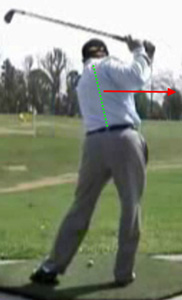
Brady Riggs demonstrating a reverse pivot - from his swing video (see above)
Note that Brady Riggs is in a reverse pivot position and that he is leaning towards the target, and that his spine (green dotted line) is tilted to the left (towards the target). Also, note that the leftward tilt of the spine causes his head to be left of the center of his stance. That's a terrible situation to be in at the start of the downswing, because the spine first has to move to the right (in the direction of the red arrow), and away from the target, before he can effectively swing his arms down towards the ball. How much support can the stabilising structure of his body provide if it is moving away from the target while the arms are swinging in the opposite direction (in the direction of the target) and how fast can his hands be pulled down towards the ball?
Consider a simple analogy. Imagine a boxer standing about 18-24" in front of a boxing bag, and imagine that he is going to punch the boxing bag with the maximum amount of power. How much punching power can he generate if he stands perfectly erect with his feet close together? Very little - because as he straightens out his right arm in a vigorous punching motion, his body is not providing him with any stabilising structural support, and his body is likely to topple forward in the direction of the punching bag. Now imagine the boxer altering his posture so that he has his left foot forward and his left knee slightly flexed, while he leans his upper torso (spine) away from the punching bag. Then he can hit the punching bag with much more force - while using the same right arm punching motion. The reason for the increased punching power is due to the fact that he can lean forward into his slightly flexed left leg while he keeps his head back in a stationary position. By keeping the head and left foot stationary, he is creating a stabilising physical structure within his body, that supports the right arm punching motion and prevents the right shoulder socket from moving too far forwards during the punching action, while at the same time absorbing the Newtonian counterforces that move in the opposite direction. Now imagine the equivalent of "reverse pivoting" by imagining the boxer leaning his upper body towards the punching bag before he executes the punching action, while keeping his two feet close together. What will happen during the right arm punching motion is that his upper torso will be flung reactively backwards away from the punching bag - due to Newtoniain counterforces - and this movement of his right shoulder socket away from the punching bag will decrease the force of the punching blow.
Reverse pivoting can be a major power leak source in a beginner golfer's swing. Professional golfers can still swing effectively from a slight revere pivot position, but even they lose a certain amount of swing power as a result of reverse pivoting.
Consider an example of an excellent golfer's swing that was handicapped by reverse pivoting.
Anonymous golfer swing comparison
In the first two images of the anonymous golfer's swing, note that he has a slight reverse pivot at the end of his backswing (image1) and that he loses a significant amount of his wrist lag in the early downswing (image 2) - presumably due to the fact that he had to move his upper spine away from the target before he could pull his hands rapidly downwards. In the second swing sequence, he has a good backswing hip pivot movement and he gets his entire spine tilted to the right without any leaning of the upper spine/head over to the left (image 3), and this results in a much better downswing movement with an amazing amount of wrist lag (image 4).
The Downswing Pivot
Consider what happens during the downswing from a hip pivoting perspective.
Aaron Baddeley - from reference number [1]
In this composite photo, I have combined an image of Aaron Baddeley at the end-backswing position and another image of him at the immediate post-impact position. Consider what hip movements must have occurred in the downswing phase of his swing. At the end of his backswing he is pivoting over his slightly flexed right leg, and at impact he is pivoting over a straightened left leg. Therefeore, the following hip pivoting events must have happened in the downswing - i) he must have pivoted off his right femoral head and ii) he must have slid his entire pelvis to the left so that he could start pivoting his left hemi-pelvis over his left femoral head. In other words, he had a right hip pivoting-off action, a pelvis slide movement and a left hip pivoting-on action.So what is the best method of starting this sequence of hip pivoting movements? There are an amazing number of contrary opinions as to the best method of starting the downswing's lower body movements. Many golfers think of initiating the downswing by moving a single body lower part eg. pushing the right hip around, kicking-in the right knee, kicking-off the right foot, pulling back on the left hip and on-and-on. I think that it is major mistake to think of a single body movement when initiating the downswing, and I think that it is better to think in 'big' pictures (mental images of the movement of the entire pelvis in space).
My favorite way of thinking of hip movements at the start of the downswing is derived from this swing video.
http://www.youtube.com/watch?v=NNwSfz0_KDM
Shawn Clement, the Canadian golf instructor, starts off by demonstrating how one should perform a backswing hip pivot movement - by wiping the right buttock against the glass window in the direction of the target. That's a good swing thought for a beginner golfer who has difficulty performing a "correct" backswing hip pivot movement.
Note what he states about starting the downswing's lower body movements. He recommends that one keep the right buttock back where it was at the end of the backswing (at the tush line), and he recommends that one should think of pulling the left buttock back against the glass window and wiping away from the target (pivoting the left hemi-pelvis back and to the right, so that it is against the tush line). In other words, he is recommending that one should focus one's attention on the left hemi-pelvis, and he recommends that one should think of pulling the left hip back in a left hip clearing action - without allowing the right buttocks to move away from the tush line in the direction of the ball-target line.
Ben Hogan recommended a left hip clearing action in his book [4].
Ben Hogan's idea of an elastic strip - from reference number [4]
Ben Hogan stated that one should "imagine, that at address, one end of an elastic strip is fastened to a wall directly behind your left hip and that the other end is fastened to the left hip bone." Then, during the backswing, when the hips rotate 45 degrees to the right, the elastic strip becomes stretched. The downswing starts when the elastic strip snaps back, rapidly rotating the hips around to the left. In other words, the initiating hip movement is a rapid shift-rotation of the left hip back around to the left (hip squaring action).However, there is one major point that is different about Hogan's description/diagram - compared to Shawn Clement's swing video recommendations. The Hogan diagram shows the right pelvis rotating well forward across the toe line - while the left pelvis rotates backwards. It is a mistake to think that the right hip has to move forward of the toe line when the left hemi-pelvis is pulled back towards the tush line. It is possible to pull the left hemi-pelvis back towards the tush line without moving the right hemi-pelvis forward of the toe line (although the unitary structural integrity of the pelvis dictates that the right hemi-pelvis must be moving forward away from the tush line as the left hemi-pelvis moves back towards the tush line). If one adopts the wrong hip-squaring approach - immediately rotating the right hip forward over the toe line to square the hips - then it pulls the right buttocks off the tush line and predisposes one to an 'over-the-top' move as the pelvis, and subsequently the right shoulder, spins forward. There is an additional problem if a golfer starts the downswing hip movement with a right hip rotation movement towards the ball-target line - because if the right hip is brought forward, then both hips are too far forward over the toes, and the golfer will become unbalanced with a tendency to fall foward over his toe line. Beginner golfers must therefore consciously avoid spinning the right hemi-pelvis forward at the start of the downswing.
Consider a "real life" sequence of Ben Hogan's hip movements during the downswing (from a swing video).
Ben Hogan - downswing sequence
I have placed red lines alongside Hogan's hips at the end-backswing position (image 1). As the downswing progresses, one can see that he first slides his pelvis to the left, but there is no evidence that he prematurely rotates his right hemi-pelvis forward (towards the ball-target line). One can also note that he is putting more weight on the left foot as the downswing progresses. Note that his right knee doesn't have to kick-in to enable him to transfer weight over to his left side, although he is probably pushing off the inside of his right foot during this weight transfer action. Note that he doesn't over-slide the hips to the left, and the outer border of his left hip never goes left of a point that is vertically in line with the inner border of his left foot. In other words, he only slides his pelvis enough to the left so that can put most of his weight over a straightening left leg. From that point onwards, his left hemi-pelvis is pivoting around to the left over the left femoral head as the left leg becomes increasingly straightened.This series of swing images enables a beginner golfer to develop a mental image of the "correct" sequence of hip movements in the downswing - a progressive replanting of weight onto the left foot, which occurs secondarily to the pelvis sliding to the left, followed by a pivoting of the left hemi-pelvis over a straightening left leg (left hip clearing action) that causes the left pelvis to rotate back to the tush line. In other words, a good "downswing initiating" mental image for a beginner golfer is to think of getting one's weight over onto the left foot followed by an immediate sensation of actively pulling the left hemi-pelvis back (away from the ball-target line) towards the tush line. This mental image should help a beginner golfer avoid the fault of sliding the hips too far to the left. If the pelvis slides too far to the left, and the outer border of the left pelvis gets beyond the outer border of the left foot, then the lumbar spine, and often the entire lower torso, moves ahead of the ball by impact.That will usually result in a weak push-slice shot - because the hands are too far ahead of the ball by impact and there is no opportunity for the clubface to close by impact, and there is also no "firm left side" to support the actively moving torso. In the above photo-sequence, one can appreciate that Hogan is hitting into a "firm left side" (straightening left leg) and that he is pivoting around an imaginary axis (between his stationary head and his left foot) to the left. Note that Hogan keeps his head stationary throughout the entire downswing, and this helps him firm-up the entire left side of his lower torso as his body pivots around (the imaginary axis) to the left.
When does Hogan pivot-off the right femoral head? It obviously occurs in the later stages of the downswing as he puts progressively more weight on the left foot. At some point, the right femoral head must become sufficiently unweighted that it is reasonable to conclude that he can be considered to be pivoting his pelvis off the right femoral head. A sign of the unweighting of his right femoral head is the bending of his right knee and the lifting of his right heel off the ground. These two body part movements are not active movements, but passive movements that occur automatically when the right femoral head becomes unweighted in the later downswing, and the right hemi-pelvis rotates forwards. That's why a beginner golfer should not think of actively kicking-in the right knee, and/or actively pushing the right heel off the ground in the early downswing.
Here is another swing video sequence example demonstrating the same points.
Aaron Baddeley downswing series - from reference number [1]
I have placed red lines alongside the outside of Aaron Baddeley's thighs when he is at the end-backswing position (image 1). Note how Aaron Baddeley squares his hips in the early downswing (image 2) by pulling the left hip back towards the tush line (away from the ball-target line) and not by thrusting his right hip forward (towards the ball-target line). Note how his right pelvis eventually rotates forward later in the downswing (image 3) and that causes his right heel to passively lift up, and his right knee to passively kick inwards, by the time he reaches the impact position (image 4).Note how "quiet" Aaron Baddeley's legs are throughout the downswing.
Brady Riggs recommends "quiet" legs in this swing video.
http://www.youtube.com/watch?v=bzx0tLOckiY&mode=related&search
To be able to see an excellent swing video example of a good backswing/downswing hip pivot action - look at this swing video of Mike Austin's swing (especially the first four swings in B&W taken when he was still very young). Note how he rotates his right buttocks in the backswing pivot action (so that it wipes against an imaginary glass wall in a targetwise direction) and note how he pulls his left buttocks back during the downswing pivot action (so that it rubs against an imaginary glass wall in a direction that is away from the target). Most importantly, note the fluidity of his hip movements, and the remarkable synchrony of his upper and lower torso movements. Mike Austin once drove a ball 515 yards (wind-assisted) in competition when he was 64 years of age!
http://www.youtube.com/watch?v=IoqZufP3UJc&mode=related&search=
Jeff Mann.
June 2007.
References:
1. V1 Home Swing Analyser website. http://v2.v1home.com
2. The 7 Laws of the Golf Swing. Nick Bradley.
3. A Swing for Life. Nick Faldo.
4. Five Lessons: The Modern Fundamentals of Golf. Ben Hogan.
5. Perfect Pivot - Part 1: Backswing Pivot. Brian Manzella.
http://www.brianmanzella.com/forum/showthread.php?t=3675&highlight=article(Registration required)
